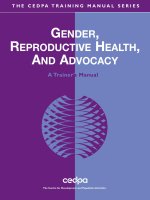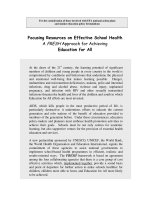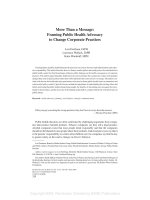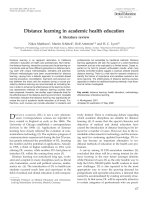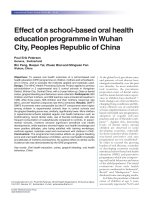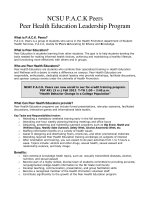Community-Based Health Education Intervention: A Service-Learning Approach docx
Bạn đang xem bản rút gọn của tài liệu. Xem và tải ngay bản đầy đủ của tài liệu tại đây (57.38 KB, 11 trang )
Forum on Public Policy
Community-Based Health Education Intervention: A Service-Learning
Approach
Srijana M. Bajracharya, Associate Professor, Department of Health Promotion and Physical
Education, Ithaca College
A variety of best practices concerning community-based health education intervention
has been developed and administered. Integrating service-learning projects into community
health programs through academic credit-bearing courses can make such programs more
effective and meaningful because programs incorporating service-learning projects can have a
major effect not only on the target population, but also on other populations in the community.
This paper will cover how health education program planners can involve college and
university students—future health professionals—in service-learning projects and integrate these
projects into community health programs. Such projects encourage students to apply what they
have learned in the classroom in real-world settings. These activities ensure that the service
being provided and the learning that is occurring receive equal attention and benefit both
students and clients. The participation of college and university students (who often have
abundant energy and motivation) can help make community health programs cost effective and
advantageous to all involved. This paper will present sample projects and models in order to
show how health professionals can include college and university students in partnerships to
provide health education programs and to support comprehensive community health promotion
and disease prevention activities.
Introduction
Sustaining a healthy community is the goal of every part of the world. However,
achieving this goal requires careful planning and organizing by community members, health
organizations, academic institutions, and various government agencies. Although, in terms of
education, technology, health resources, and per capita purchasing power, the United States is
one of the best countries to live in, it falls short in terms of delivering the best health care at a
reasonable cost. About 45 million—15.6% of the total population—are not covered by health
insurance (U. S. Census Bureau 2003). Yet, the United States, which spends 16% of its GDP on
health care, spends more on health care per capita than any other industrialized country. For
example, Switzerland and Germany (which also spend a relatively high percentage of their GDP
on health care) each spend 11% of their GDP on health care. In 2004, the cost of health care in
the United States rose 7.9% to $1.9 trillion, or an average of $6,280/person (National Center for
Health Statistics 2006). Obesity and obesity-related health problems have become a national
crisis. National data indicate that people in the lower economic brackets are most vulnerable to
such problems. These statistics show why even a highly industrialized country like the United
States is looking for innovative ways to meet the health needs of its communities.
1
Forum on Public Policy
Health promotion and disease prevention initiatives
Disease prevention has become a well-known verity for the health care profession.
However, preventive activities, as they are intangible in nature, must be carefully planned.
Several government agencies, private and public academic institutions, and even religious
organizations have been responding to the national health care crisis for decades. Health
promotion and disease prevention initiatives originated in the ’70s. While health promotion
programs (which address political, economical, and environmental factors) are a much broader
disease prevention strategy than health education, health education is the core of these programs
(McKenzie, Neiger, & Smeltzer 2005). Hence, health education has become an important part of
the programs of all health service organizations (figure 1).
Providing effective health education can be challenging. It can be delivered properly
only by professional health educators. The current formal definition of health education includes
activities beyond merely classroom lectures about health. The responsibilities of today’s health
educators include not only teaching health effectively, but also assessing the needs of target
populations and planning, implementing, and evaluating programs (NCHC 2007). Additionally,
professional health educators should be proficient in collaborating and coordinating programs
with others and communicating health information to the public. To ensure the quality of health
education preparation programs, the National Commission for Health Education Credentialing,
Inc. (NCHEC) created the Certified Health Education Specialist (CHES) exam for academically
trained health educators. Those who pass the exam indicate that they fulfill all of the
competencies of being professional health educators (NCHEC 2007).
Meeting the needs of citizens: a national effort
Faculty who are preparing professional health educators should provide students with
authentic experiential learning so that they can design programs that are effective, acceptable,
and innovative. Many faculty across the United States are using service-learning projects to
enhance students’ learning through hands-on experience. In 1985, the presidents of Brown,
Georgetown, and Stanford universities and the president of the Education Commission of the
States founded Campus Compact (Campus Compact b 2007), a coalition of over 1,000 college
and university presidents devoted to using university resources (including the talents and skills of
faculty, students, and staff) to support service-learning projects and other programs to help
fellow citizens in need (Campus Compact a 2007).
2
Forum on Public Policy
According to Andy Furco (1996), service-learning “programs are distinguished from
other approaches to experiential education by their intention to equally benefit the provider and
the recipient of the service as well as ensure equal focus on both the service being provided and
the learning that is occurring.” Furco explained that the different types of service programs can
be distinguished by their primary purpose and focus. Although other service programs, such as
field education and community service, also serve the community, their primary beneficiaries are
either students or members of the community. Service-learning programs are the only service
programs that equally benefit “the provider [students] and the recipient [community partner] of
the service as well as ensure equal focus on both the service being provided and the learning that
is occurring.” This balance distinguishes service-learning from all other experiential education
programs.
The major criteria of service-learning are that the project be part of an academic course;
the project’s objective match one or more of the course objectives; there be a community partner
to serve; the community partner contribute to student learning; students examine their successes
and failures; and students celebrate their work (Furco 2000). In summary, there are four phases
of service-learning: planning, action, reflection, and celebration (Greenberg, 2000).
Faculty who intend to integrate service-learning projects into their courses must work
ahead of time to ensure that all four phases can be completed within the semester. By the time
classes begin, these faculty should have already recruited a community partner. They must
brainstorm and flesh out the topic and the activities that the students should be working on based
on the content of the course. There has to be a formal agreement between the community
partners and students. The faculty member should be a liaison between the two parties.
Integration of service-learning in health education
Although service-learning can be used in many academic disciplines, health education
seems to be a natural fit for this kind of hands-on activity for both undergraduate and graduate
students. Greenberg (1997) described many courses offered by the University of Maryland’s
Department of Health Education that have integrated service-learning. He recommended that the
department establish a partnership with the city office or other pertinent community partners so
that the department can have a regular site for service-learning projects. Not all academic
institutions can establish such sites. In such cases, individual faculty must establish partnerships
with local health agencies or city offices. The faculty member has to invest a tremendous amount
3
Forum on Public Policy
of effort in the beginning. Also, students initially resist the extra work required. In my
experience, however, their resistance dissipates once they see the value of service-learning.
Most nonprofit health agencies are overburdened with community service demands. In
addition, because of low funding and the lack of qualified, experienced health educators, health
agencies struggle to provide adequate community health programs. Although assessing the needs
of the target population before planning health education programs and evaluating such programs
after they have ended are important, health agencies lack enough professionals that are prepared
to do these tasks; therefore, health agencies do not do the necessary preliminary work or
subsequent evaluations (Bajracharya, 1999). Using service-learning projects to help community
partners implement health care activities would be a tremendous help for these organizations.
Students gain tremendously from these hands-on activities and absorb the material better.
Service-learning can be integrated into both content and method courses. While
content courses are designed to educate target populations about a particular subject
(the content of the course) directly, method courses help community partners (directors,
coordinators, and CEOs) to assess needs and plan and evaluate programs. For example, students
from the nutrition (content) class can teach the basics of nutrition to a variety of people in a
variety of settings—from schoolchildren to senior citizens. Service-learning projects can be
integrated into many other types of content courses, such as stress management, sexuality, drug
education, environmental health, mental health, wellness, and consumer health.
The integration of service-learning into method courses, such as needs assessment, policy
analysis, and evaluation, can be more extensive. These courses involve actual research. It is
advisable to make basic research and statistics courses prerequisites for such method courses so
that students will have some basic skills to conduct both qualitative and quantitative research.
Students must also be conversant in the ethical issues surrounding working with human subjects.
Examples of method courses are needs assessment, program planning, evaluation, policy
evaluation, policy assessment, and advocacy (figure 2).
Examples of service-learning projects
A variety of service-learning projects are integrated into different content and method
courses in our department. Here are examples of service-learning projects:
1. A sustainable health and wellness fair for the campus and local community
2. Needs assessment for a variety of community health programs:
4
Forum on Public Policy
a. Patient compliance for screening for a local clinic
b. Employee fitness programs for the local hospital
c. HIV education programs in schools
d. Sex education programs for a college health services department
e. Analyses of school food programs
f. A sexual harassment/abuse program for freshmen at a university
g. A needs assessment of smoking programs for a college
h. An evaluation of student health services for a college
i. An evaluation of a T-Free Zone program for the county health
department.
All of the needs assessment and evaluation projects are completed before the end of the
semester. Students are required to present their findings at the end of semester to the community
partners, students from other classes, and other faculty members. A series of recommendations
are offered to the respective organizations so that they can continue to improve their
programming or start new programs. The completed reports are submitted to the community
partners after the semester is over. Furthermore, students present their findings at the college-
wide research symposium, and sometimes they also present papers at the national conference
such as American Association of Health, Physical Education, Recreation, and Dance
(AAHPERD). Such presentations allow students to take maximum advantage of their service-
learning projects. Not only do students learn the subject matter better and apply what they learn
by doing these activities, students get experience in writing scientific papers and presenting them
at professional health-related conferences. At the end of the semester, students are asked to
reflect on their experiences and submit their reflections to the instructor. A reception is usually
organized either through the project’s grant or faculty sponsorship to celebrate the students’
accomplishments. This gives students an opportunity to express a sense of accomplishment,
showcase their work to relevant partners, and have closure.
Students’ reflections
Student reflections are critical components of service-learning activities. Fertman (1994)
says that “without reflection, students may simply go through the motions of service but remain
cognitively unaffected by the experience and left with their personal ignorance and biases
reinforced and unexamined” (p. 15). Kerrigan and Sirkin (1996) have explained several
5
Forum on Public Policy
outcomes that occur when programs contain structured reflections. According to them, service-
learning
-
facilitates intellectual growth and develops critical thinking;
-improves student communication skills;
-helps students reframe and readdress real-life situations;
-examines students’ connections to their community;
-provides students the opportunity to offer each other support and recognition;
-develops a sense of belonging among students;
-develops student recognition of themselves as change agents within the community;
-facilitates acknowledgment of community needs; and
-empowers students to recognize their strengths and skills.
These student reflections were compiled from various classes:
“Even though the semester-long project was very time consuming, it was very rewarding at
the same time, which I really liked.”
“Even though I complained about the project, I think that participating in a year-long
project is a much better learning experience/evaluation of knowledge.”
“I gained so much knowledge throughout this entire process. I learned the significance of
submitting an IRB application when dealing with human subjects. This step cannot be
overlooked.”
“This experience does not compare to any other group project or class in terms of learning
how to go about something so complex, as this class did. I can use our final portfolio for
years to come at job interviews and as a model for others.”
“I ended up really enjoying the health fair. Previous to the actual event I was nervous and
dreading it. But then realized how much I had learned from the topic and how much my
knowledge could benefit others. It caused me to really reflect on my own preferences and
opinions regarding health care options. So I want to thank Professor Bajracharya for
challenging me in this way.”
“The wellness fair also helped us build our understanding of this subject.”
“It was also interesting taking part in the health fair.”
Community partners’ reflections
6
Forum on Public Policy
Although community partners are not required to reflect on the students’ work, they
usually express their gratitude to students for helping out with such a big responsibility. Here are
examples of thank you notes written by community partners to faculty:
“Thanks so much for your help! And this will be very helpful to send along with our
accreditation application.”
“They did such a great job and we'd like to follow up on their recommendations. Kelly
Friedman is working on the BeneFITS Your Life program this semester. I've cc:d
her on this email as she will be reviewing the results as well. Thanks a lot!”
“Srijana once again asked me to be a community partner for her Assessment class. Once
again, her students were interested, well directed, creative, and produced an admirable report
and programming regarding their assessment of student attitudes, knowledge, regarding the
use/non-use of contraceptives by Ithaca College students.”
Fulfilling organizations’ missions
In addition to enhancing student learning and providing community service, the service-
learning activity is also a vehicle to fulfill one of the institution’s most important missions:
community service. For example, Ithaca College’s mission statement includes this statement:
“Learning at Ithaca extends beyond the classroom to encompass a broad range of residential,
professional, and extracurricular opportunities.”
The School of Health Sciences and Human Performance’s mission statement includes this
phrase: “Using experiential learning as a means to integrate theory and scholarship with
professional practice.”
Conclusions
Service-learning profoundly affects all parties: students, the target population (the
community), community partners (organizers), faculty, and the institution. These benefits can be
long lasting and life altering for some (Bajracharya and Spear 2000; Welle-Graf 2000). We can
certainly say that this is a win-win situation for all involved. For students, such experiential
learning can be most valuable and meaningful.
Evidence of participation in service-learning projects can be a valuable part of a
student’s professional portfolio. More colleges and universities are now advising students to
prepare both a hard copy and an electronic version of their professional portfolios (Farr and Rone
1994). A well-organized portfolio with samples of actual work with real people can be a good
7
Forum on Public Policy
way to induce future employers and admission personnel to help further a future employee’s or a
future graduate student’s education. Besides receiving free services (community-based health
education), community partners get to contribute to the student’s learning. This may increase
their organizations’ self-esteem and morale, too. The unusual experiences and accomplishments
that a faculty member gains from implementing service-learning projects may enhance his or her
professional dossier.
Maintaining service-learning partnerships requires a commitment to address barriers and
challenges. According to Welle-Graf (2000), maintaining service-leaning partnerships requires
substantial ongoing support, training, and management. Having a designated office and a
coordinator in colleges and universities to conduct such activities and “put[ting] the money in the
right place” are strongly advised. More colleges and universities need to advocate and adopt
such policies and make service-learning an integral part of higher education. The collaboration
between all parties can eventually enhance community-based health education activities
tremendously and help meet the goals of health promotion and disease prevention in the United
States and elsewhere. Service-learning programs are one way of responding to the pervasive
health needs of communities and underserved populations with the least expense and the most
benefit.
References
Bajracharya, S. M., and C. Spear. 1999. The student perspective. In Service learning in health
education, ed. Jerrold Greenberg. 123-131. Reston, VA: AAHE.
Bajracharya, S. M., and C. Spear. 1999. The student perspective. In Service learning in health
education, ed. Jerrold Greenberg. 123-131. Reston, VA: AAHE.
Campus Compact. a. About us. Brown University, Providence, RI. 2007.
———. b. History of Campus Compact. Brown University, Providence, RI. 2007.
Conrad, D., and D. Hedin. 1990. Learning from service experiences. In Combining service and
learning. Vol. 2, ed. J. C. Kendall. Raleigh, NC: National Society for Internships &
Experiential Education.
8
Forum on Public Policy
Farr, R., and B. Tone.1994. Performance assessment: Helping students evaluate their progress as
readers and writers. Fort Worth, TX: Harcourt Brace.
Fertman, D. 1994. Service learning for all students. PDK Fastback 375. Bloomington, IN: Phi
Delta Kappa Educational Foundation.
Furco, A. 1999. Service learning: What it is and what it is not. In Service learning in health
education, ed. Jerrold Greenberg. 12-17. Reston, VA: AAHE.
Greenberg, J. S. 1999. Need for service and service-learning. In Service learning in health
education, ed. Jerrold Greenberg. 133-137. Reston, VA: AAHE.
Kerringan, S., and K. Sirkin. 1996. Integrating service and reflection in students
development programs. Portland State University Capstone Facilitators Training
Packet.
McKenzie, J. F., B. L. Neiger, and J. L. Smeltzer. 2005. Planning, implementing, and evaluating
health promotion programs. 4th ed. Boston, MA: Allyn and Bacon.
National Center for Health Statistics. Health, United States, 2006 with chartbook on trends on
the health of Americans. Hyattsville, MD: 2006.
U. S. Bureau of the Census. Statistical Abstract of the United States: 2006. Washington, DC,
2005.
Welle-Graf, H. M. 2000. Establishing and maintaining community service-learning partnerships.
In Service learning in health education, ed. Jerrold Greenberg. 133-137. Reston, VA:
AAHE.
9
Forum on Public Policy
Figure 1:
Health Education as a part of various health-related organization activities
Religious Org.
Voluntary Health Org.
Federal Govt.
Health Education
State Dept
Local Health Dept
Private clinics
Academic Institutions:
College/univ/schools
Religious Org.
Voluntary Health Org.
Federal Govt.
Health Education
State Dept
Local Health Dept
Private clinics
Academic Institutions:
College/univ/schools
Hospitals
10
Forum on Public Policy
11
Figure 2:
Service-Learning in Health Education Curriculum
Research
Method courses
Health Policy Evaluation
Method courses
Education
Content courses
Program evaluationNeeds assessment
Nutrition, Stress Management., Wellness, Drug Education, Mental
Health, Environmental Health, Sexuality Education, Consumers Health
Policy advocacy
Policy needs
assessment
Policy evaluation
Published by the Forum on Public Policy
Copyright © The Forum on Public Policy. All Rights Reserved. 2006.

